How to Protect Car Paintwork from Scratches
Want to know how to protect car paintwork from scratches? You’re in the right place. We’ll share simple and effective tips to help you keep your car’s paint looking pristine.
Key Takeaways
- Understanding the causes of car scratches, including environmental factors and improper washing techniques, is key to prevention.
- Choosing parking spaces wisely and being aware of surroundings can significantly reduce the risk of paint damage.
- Regular inspections and maintenance of your car’s paintwork help identify and address damage early, preventing costly repairs.
Understand the Causes of Car Scratches
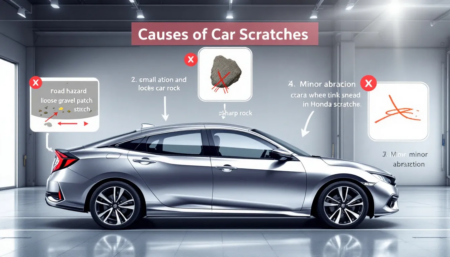
Knowing what causes car scratches is the first step in preventing them. Everyday activities such as parking too close to other vehicles and driving on loose gravel roads can lead to minor scratches or even deeper damage. Accidental contact with other motorists and objects in parking lots is a common culprit for car scratches. Additionally, debris on the road, like small scratches and light scratches, can be flung up and cause significant scratched to your car’s surface.
Environmental factors also play a significant role in causing paint damage. Natural elements such as tree sap and bird droppings can damage your car’s paint if not cleaned promptly. Vandalism, although less common, can result in severe scratches that require costly repairs. Even improper washing techniques can inadvertently scratch your car’s surface. Using rough materials or harsh cleaning agents can lead to minor abrasions and fine scratches.
Regular washing prevents contaminants from embedding into the paint, avoiding scratches over time. Understanding these causes enables car owners to take proactive steps to protect their car’s finish.
Choose Your Parking Spaces Wisely
Choosing the right parking space can make a significant difference in preventing scratches. Parking lots are notorious for causing paint damage due to the close proximity of other vehicles. Opt for parking spaces with ample room between cars to minimise the risk of accidental contact and scratches.
Avoid parking under trees, as falling debris and bird droppings can cause damage to your car’s paintwork. Instead, look for well-lit and secure car park areas that are not exposed to direct sunlight or in a shaded area. These spots not only offer better protection from environmental elements but also reduce the likelihood of vandalism. If possible, park in a garage to provide the best solution for protecting your car regularly.
Being mindful of your surroundings when parking is crucial. Check for low-hanging branches, poles, and other obstacles that could scratch your car’s surface. Taking a few extra moments to choose your parking spot wisely significantly reduces the risk of scratches and helps keep your car looking new.
Use Proper Washing Techniques
Proper washing techniques are crucial for maintaining your car’s paintwork and preventing scratches. The two bucket method, which uses one bucket for soapy water and another for rinsing, helps keep dirt and contaminants separate, reducing the risk of scratching your car’s surface.
Using high-quality micro fiber towels is another crucial aspect of proper washing. These towels can lift dirt away without grinding it into the paint, preventing fine scratches and swirl marks. Additionally, applying pre-wash foam can remove a significant amount of grime before the main wash, minimising the chance of scratches. Always rinse the car from top to bottom to avoid leaving soap residue and streaks.
Using a pH-balanced car shampoo ensures dirt removal without damaging existing wax or sealants. Regular washing with these techniques maintains the car’s finish and prevents long-term paint damage.
Dry Your Car Correctly
Drying your car correctly is as important as washing it. Improper techniques can cause swirl marks and minor scratches. Gently pat dry the surface with a soft microfiber towel instead of wiping to prevent these issues and water spots by absorbing water without causing friction.
Soft microfiber towels are highly recommended for drying due to their absorbent and gentle properties. These towels reduce the risk of scratching the car’s surface and ensure a streak-free finish. Blow drying is another effective method for removing water from hard-to-reach areas, further reducing the risk of scratches when done correctly. A dry cloth can also be used for a final touch.
Proper drying prevents minor scratches and maintains the polished, pristine look of your car’s paintwork. Regularly using these techniques helps protect your car’s finish and keeps it looking its best. Additionally, using a quality polish can enhance the overall appearance.
Apply Protective Coatings
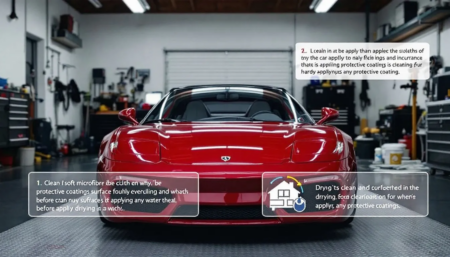
Applying protective coatings is an excellent way to safeguard your car’s paint from scratches and other environmental damage. Ceramic coatings and clear coat are a popular choice among car owners because they chemically bond to the vehicle’s paint, providing superior protection against scratches, UV rays, and corrosion. These coatings can last for the lifetime of the vehicle if applied correctly.
Another option is synthetic paint sealant, which can last up to six months and provide shorter-term protection. Combining waxing with ceramic coatings can yield both aesthetic appeal and durable protection for your car. While wax needs regular reapplication, ceramic coatings maintain their protective qualities for much longer.
Selecting the right protective layer coating is crucial for the long-term maintenance and appearance of your car’s paintwork. Investing in these measures ensures better protection and longer protection while reducing the need for costly future repairs.
Install Paint Protection Film (PPF)
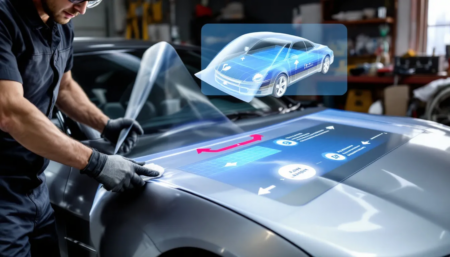
Paint Protection Film (PPF), also known as a clear bra, is an excellent solution for protecting high-impact areas of your car from scratches, chips, and road debris. This invisible layer is designed to absorb impact and shield your car’s paint from damage. Installing PPF on areas like the front bumper and hood can significantly reduce the risk of paintwork damage.
One of the main benefits of PPF is its longevity. Depending on maintenance and environmental factors, PPF can last between 5 to 10 years. This makes it a valuable investment for car owners looking to protect their vehicle’s paintwork for the long term.
Installing Paint Protection Film ensures your car remains in top condition, reducing the need for touch-up paint and repairs. This proactive step helps maintain the beauty and value of your vehicle.
Avoid Automatic Car Washes
Automatic car washes might seem convenient, but they can be detrimental to your car’s paintwork. The stiff bristles and abrasive brushes used in these car wash services can leave fine scratches on your car’s surface. Additionally, the harsh chemicals often used can further damage the paint.
Instead, consider hand-washing your car using proper techniques. This safer alternative allows you to control the process and ensure that your car is washed without causing any damage.
Avoiding automatic car washes helps maintain the integrity of your car’s paint and prevents unnecessary scratches.
Be Mindful of Your Surroundings
Being aware of your surroundings is crucial for preventing accidental scratches. Practicing defensive driving can help you avoid potential paint damage from debris and other vehicles, as well as from other drivers. Keeping a reasonable distance from other cars while driving reduces the risk of accidental contact and scratches.
When parking, take the time to check for obstacles such as low-hanging branches, poles, and other protruding objects. Avoid driving compact parking spaces to minimize the likelihood of accidental collisions. Additionally, be mindful of nearby objects and surfaces when entering or exiting your car to prevent scratches. Here are some tips to help you park safely.
Staying vigilant and taking these preventive measures significantly reduces the risk of paint damage and helps keep your car paint looking its best efforts.
Use Car Covers
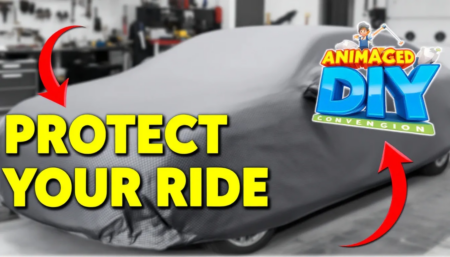
Using a car cover is an effective way to protect your car from environmental damage and minor scratches. Car covers shield your vehicle from dust, dirt, and debris that can cause paint damage. High-quality car covers with soft inner linings are essential for preventing scratches and ensuring your car’s paint remains in top condition.
Breathable car covers offer additional protection by allowing moisture to escape while shielding the vehicle from environmental factors. When choosing a car cover, ensure it fits well and is made from materials that won’t scratch the paint.
Regular use of a car cover protects your vehicle from various elements and maintains its pristine appearance. It’s a simple yet effective way to keep your car scratch-free.
Regularly Inspect and Maintain Your Car’s Paintwork
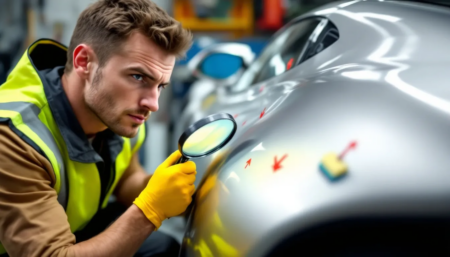
Regular inspections of your car’s paintwork are crucial for maintaining its appearance and value. Car owners should routinely check for signs of scratches or damage and address any issues promptly. Neglecting minor scratches and unsightly scrapes can lead to rust and further deterioration of the paintwork.
Fixing scratches as soon as possible helps maintain the car’s aesthetic and prevents the need for extensive repairs later. Regular maintenance, such as drying your car correctly, can also prevent water-related corrosion and ensure the longevity of your car’s finish. To fix car scratches effectively, addressing them promptly is key.
Regular inspections and maintenance keep your car’s paintwork looking new and extend its lifespan. This proactive approach pays off in the long run.
Summary
Protecting your car’s paintwork from scratches requires a combination of understanding the causes, choosing the right preventive measures, and being mindful of your surroundings. By implementing the tips shared in this blog post, you can maintain the beauty and value of your car for years to come.
Remember, a scratch-free car isn’t just about aesthetics; it’s about preserving your vehicle’s integrity and ensuring it remains in top condition. Take these steps to heart, and enjoy the confidence that comes with driving a well-maintained vehicle.
Frequently Asked Questions
What are the most common causes of car scratches?
Car scratches often result from accidental contact with other vehicles, road debris, improper washing techniques, and environmental elements such as bird droppings and tree sap. Taking preventive measures can help keep your vehicle looking pristine.
How can I choose a safe parking space to avoid scratches?
To avoid scratches, choose well-lit and secure parking areas, steer clear of trees, and park with ample space between your vehicle and others. Prioritizing these factors will significantly reduce the risk of damage.
What is the two-bucket method for washing cars?
The two-bucket method is an effective car washing technique where one bucket holds soapy water while the other is designated for rinsing your wash mitt, ensuring dirt is kept separate to minimize the risk of scratches on your car’s surface.
Are automatic car washes safe for my car’s paintwork?
Automatic car washes can damage your car’s paint due to stiff bristles and harsh chemicals. Opting for hand-washing with the right techniques is a safer choice for maintaining your vehicle’s finish.
Why should I use a car cover?
Using a car cover is essential for protecting your vehicle from dust, dirt, and environmental damage that can harm the paint. A high-quality cover, especially with a soft inner lining, will help prevent scratches and maintain your vehicle’s appearance.
